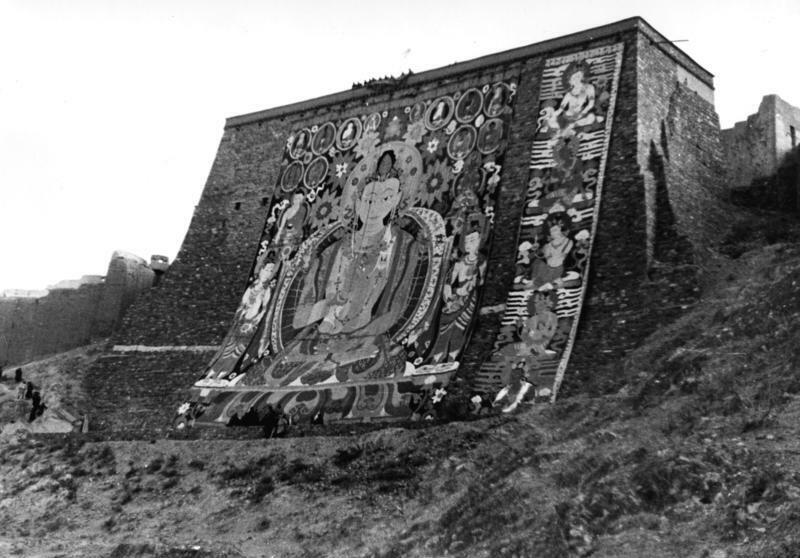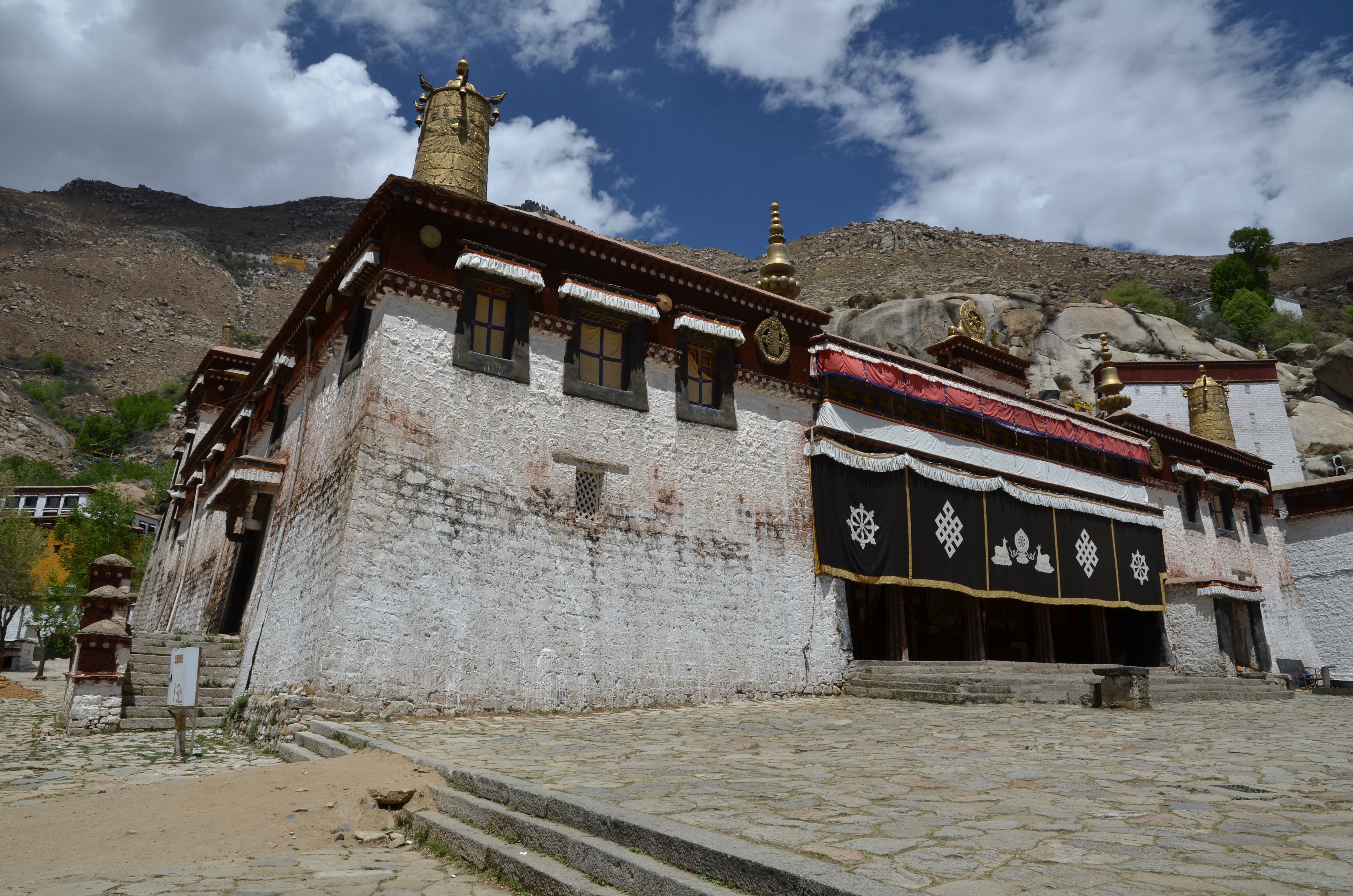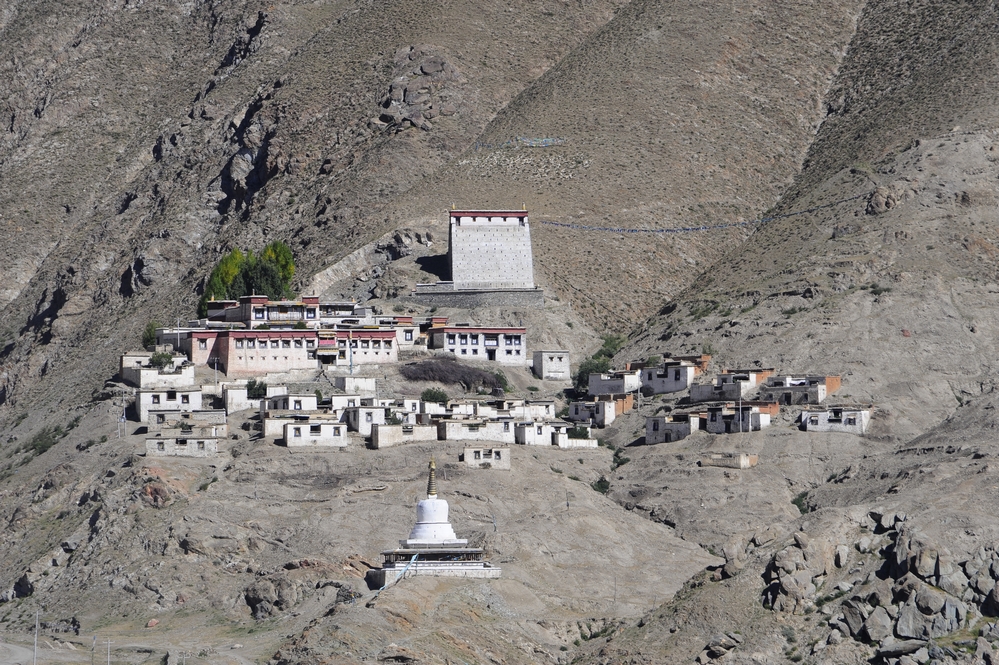Thangka Wall on:
[Wikipedia]
[Google]
[Amazon]
 A thangka wall is, in
A thangka wall is, in
 At
At
 At least four large monasteries in China's
At least four large monasteries in China's
 The massive, stark thangka wall at Palcho Chode towers above a hillside in the north-eastern part of the monastic enclosure built in 1425. The building of the wall is not supposed to have taken place before the 1430s when the associated monumental thangkas were commissioned.
During the Gyantse festival in the fourth month of the Tibetan year, the wall is used, within a two-year cycle, to display the Sakyamuni thangka in alternation with the Maitreya thangka. A third one, the Dīpankara thangka, is no longer displayed due to its poor state of repair.
The massive, stark thangka wall at Palcho Chode towers above a hillside in the north-eastern part of the monastic enclosure built in 1425. The building of the wall is not supposed to have taken place before the 1430s when the associated monumental thangkas were commissioned.
During the Gyantse festival in the fourth month of the Tibetan year, the wall is used, within a two-year cycle, to display the Sakyamuni thangka in alternation with the Maitreya thangka. A third one, the Dīpankara thangka, is no longer displayed due to its poor state of repair.

 The Tashilhunpo thangka wall stands on a hillside in the north-eastern part of the monastic complex. Because of its overbearing position, it can be seen from afar. It is the largest and the most impressive thangka wall still extant. It is approximately 32 metres high by 42 metres long at the base. It was built in 1468
The wall is used for displaying giant representations of
The Tashilhunpo thangka wall stands on a hillside in the north-eastern part of the monastic complex. Because of its overbearing position, it can be seen from afar. It is the largest and the most impressive thangka wall still extant. It is approximately 32 metres high by 42 metres long at the base. It was built in 1468
The wall is used for displaying giant representations of
 The
The
"Service by thangka wall at Palkhor Chode, Gyantse"
''The Tibet Album'', 5 Dec. 2006, The British Museum Tibetan Buddhist architecture Thangkas
 A thangka wall is, in
A thangka wall is, in Tibetan
Tibetan may mean:
* of, from, or related to Tibet
* Tibetan people, an ethnic group
* Tibetan language:
** Classical Tibetan, the classical language used also as a contemporary written standard
** Standard Tibetan, the most widely used spoken dial ...
religious architecture
Sacral architecture (also known as sacred architecture or religious architecture) is a religious architectural practice concerned with the design and construction of places of worship or sacred or intentional space, such as churches, mosques, ...
, a stone-built structure used for hanging giant, or monumental, appliqued thangka
A ''thangka'', variously spelled as ''thangka'', ''tangka'', ''thanka'', or ''tanka'' (; Tibetan: ཐང་ཀ་; Nepal Bhasa: पौभा), is a Tibetan Buddhist painting on cotton, silk appliqué, usually depicting a Buddhist deity, scene, ...
s, or scrolls, in some of the major Buddhist monasteries of Tibet. These giant thangkas are called ''gos ku'', ''goku'', ''gheku'', ''kiku'' (cloth image) in Tibetan, and ''thongdrel
A Thongdrel (alt. throngdrel) is a large appliqué religious image normally only unveiled during ''tsechus'', the main religious festivals in Bhutan. They are the largest form of ''thangka'' paintings in the tradition of Tibetan Buddhism. ...
'' in Bhutan
Bhutan (; dz, འབྲུག་ཡུལ་, Druk Yul ), officially the Kingdom of Bhutan,), is a landlocked country in South Asia. It is situated in the Eastern Himalayas, between China in the north and India in the south. A mountainous ...
. The thangka wall stands on a hillside from where it overlooks the monastic settlement. Its form is that of a narrow, elongated and tall rectangular building with a battered façade and a flat roof surrounded by a parapet. The side and rear walls are normally vertical.
Thangkas are only displayed hung on the walls on special occasions such as major festivals, when they are or were unrolled by monks at the top of the wall, with considerable ceremony. Tibetan Buddhists
Tibetan Buddhism (also referred to as Indo-Tibetan Buddhism, Lamaism, Lamaistic Buddhism, Himalayan Buddhism, and Northern Buddhism) is the form of Buddhism practiced in Tibet and Bhutan, where it is the dominant religion. It is also in majo ...
believe that viewing the thangka with the proper spirit brings great spiritual benefits. Often the thangka was only displayed on one day in the year.
Smaller monasteries that lack a special thangka wall, like those in Bhutan
Bhutan (; dz, འབྲུག་ཡུལ་, Druk Yul ), officially the Kingdom of Bhutan,), is a landlocked country in South Asia. It is situated in the Eastern Himalayas, between China in the north and India in the south. A mountainous ...
, may hang their large thangkas from the other monastery buildings, often in the main courtyard. This was presumably the practice everywhere before the emergence of special thangka walls. The creation of silk appliqué thangkas appears to have begun in China, perhaps in the 14th century, using existing Chinese textile techniques to copy painted Tibetan thangkas. These reached Tibet, where they were well received, and the Tibetans, also already used to silk appliqué for decorating tents and clothes, began to make their own. Initially these were relatively small, for hanging inside prayer-halls, but by at least the 15th century some were being made large enough that large outside locations were needed to display them.
Tibetan designations
 At
At Tashilhunpo
Tashi Lhunpo Monastery (), founded in 1447 by the 1st Dalai Lama, is the traditional
monastic seat of the Panchen Lama, and an historically and culturally important monastery in Shigatse, the second-largest city in Tibet.
The monastery was sa ...
monastery in Shigatse, the thangka wall has had the following designations:
* ''kugopea'' (Samuel Turner, 1800);
* ''gö-ku-pea'' (Laurence Austin Waddell, 1895), ie cloth-image tower;
* ''kiku tamsa'' (Laurence Austine Waddell, 1895; William Carey, 1901; Sarat Chandras Das, 1902), ie cloth-image support;
* ''gos-sku-spe'u'' (Michael Aris, 1982), ie cloth-image tower support.
At Palcho Chode monastery in Gyantse
Gyantse, officially Gyangzê Town (also spelled Gyangtse; ; ), is a town located in Gyantse County, Shigatse Prefecture, Tibet Autonomous Region, China. It was historically considered the third largest and most prominent town in the Tibet region ( ...
, the thangka wall is called
* ''gheku'' tower (Victor Chan, 1994), ie cloth-image tower;
* ''goku tramsa'' (''The Tibet Album'', 2006) or ''gos sku thang sa'' (Michael Henss, 2011), ie cloth-image support.
The words ''kugo'', ''gos-sku'', ''goku'', ''gheku'' and ''kiku'' refer to the monumental thangka (''kugo'' being apparently the result of inverting the two syllables of ''goku'' while ''gheku'' and ''kiku'' are supposed to be informal pronunciations of ''gos sku'' or ''goku'').
Architectural designations
In English-language writings, this type of building is referred to as "thangka wall" (Victor Chan, 1994; Andreas Gruschke, 2001; ''The Tibet Album'', 2006 ; Michael Henss, 2011 ; ''Tibet'', Lonely Planet, 2015 ; Diana Lange, 2016), or sometimes "support wall" (''Tibet'', Lonely Planet, 2015) or "display wall" (Ronald M. Bernier, 1997). American explorer F. Bailey Vanderhoef, Jr. uses the term "pylon" in his memoirs published in 1938. In the original captions attached to the photos taken by the 1938–39 German expedition to Tibet, the Palcho Chode edifice is called ''große Gebetsmauer'' (large prayer wall) while its counterpart at Tashilhunpo is termed ''große Tangamauer'' (large thangka wall)..Inventory
 At least four large monasteries in China's
At least four large monasteries in China's Tibet Autonomous Region
The Tibet Autonomous Region or Xizang Autonomous Region, often shortened to Tibet or Xizang, is a Provinces of China, province-level Autonomous regions of China, autonomous region of the China, People's Republic of China in Southwest China. I ...
possess a giant thangka wall : Sera (Lhasa), Palcho Chode (Gyantse
Gyantse, officially Gyangzê Town (also spelled Gyangtse; ; ), is a town located in Gyantse County, Shigatse Prefecture, Tibet Autonomous Region, China. It was historically considered the third largest and most prominent town in the Tibet region ( ...
), Tashilhunpo (Shigatse) and Riwo Dechen ( Qonggyai). The walls at Sera and Riwo Dechen are recent additions while those at Tashilhunpo and Palcho Chode are centuries-old monuments.
Sera (Lhasa)
The thangka wall at Sera stands near the Chöding hermitage (Tsongkhapa's retreat before the monastery was built). The wall is a recent replacement to a scaffolding erected on a slope. It has some semblance to its counterpart at Tashilhunpo (see beneath). The wall is used for lifting giant thangkas of the Buddha during the Shoton festival in August. The wide yard fronting the building is where the faithful gather to gaze on the giant thangkas.Palcho Chode (Gyantse)
 The massive, stark thangka wall at Palcho Chode towers above a hillside in the north-eastern part of the monastic enclosure built in 1425. The building of the wall is not supposed to have taken place before the 1430s when the associated monumental thangkas were commissioned.
During the Gyantse festival in the fourth month of the Tibetan year, the wall is used, within a two-year cycle, to display the Sakyamuni thangka in alternation with the Maitreya thangka. A third one, the Dīpankara thangka, is no longer displayed due to its poor state of repair.
The massive, stark thangka wall at Palcho Chode towers above a hillside in the north-eastern part of the monastic enclosure built in 1425. The building of the wall is not supposed to have taken place before the 1430s when the associated monumental thangkas were commissioned.
During the Gyantse festival in the fourth month of the Tibetan year, the wall is used, within a two-year cycle, to display the Sakyamuni thangka in alternation with the Maitreya thangka. A third one, the Dīpankara thangka, is no longer displayed due to its poor state of repair.
Tashilhunpo (Shigatse)

 The Tashilhunpo thangka wall stands on a hillside in the north-eastern part of the monastic complex. Because of its overbearing position, it can be seen from afar. It is the largest and the most impressive thangka wall still extant. It is approximately 32 metres high by 42 metres long at the base. It was built in 1468
The wall is used for displaying giant representations of
The Tashilhunpo thangka wall stands on a hillside in the north-eastern part of the monastic complex. Because of its overbearing position, it can be seen from afar. It is the largest and the most impressive thangka wall still extant. It is approximately 32 metres high by 42 metres long at the base. It was built in 1468
The wall is used for displaying giant representations of Maitreya
Maitreya (Sanskrit: ) or Metteyya (Pali: ), also Maitreya Buddha or Metteyya Buddha, is regarded as the future Buddha of this world in Buddhist eschatology. As the 5th and final Buddha of the current kalpa, Maitreya's teachings will be aimed at ...
(the Buddha of the future), Amitabha (the Buddha of the infinite light), and Sakyamuni
Siddhartha Gautama, most commonly referred to as the Buddha, was a wandering ascetic and religious teacher who lived in South Asia during the 6th or 5th century BCE and founded Buddhism.
According to Buddhist tradition, he was born in Lu ...
(the enlightened Buddha) on the basis of one different thangka a day during the festival taking place on the 14th, 15th and 16th of the fifth Tibetan month (ie 1, 2 and 3 July).
Riwo Dechen (Qonggyai)
 The
The kagyupa
The ''Kagyu'' school, also transliterated as ''Kagyü'', or ''Kagyud'' (), which translates to "Oral Lineage" or "Whispered Transmission" school, is one of the main schools (''chos lugs'') of Tibetan (or Himalayan) Buddhism. The Kagyu lineag ...
monastery in the possesses a thangka wall that overbears the other monastic buildings and can be seen from afar. It is a recently built addition to the complex. The front face of the building has a strong batter. A stone masonry retaining wall marks out the platform that extends outside the thangka wall.
A giant thangka of Maitreya
Maitreya (Sanskrit: ) or Metteyya (Pali: ), also Maitreya Buddha or Metteyya Buddha, is regarded as the future Buddha of this world in Buddhist eschatology. As the 5th and final Buddha of the current kalpa, Maitreya's teachings will be aimed at ...
, the Buddha of the future, is preserved and maintained by the monastery.
Mounting of the thangka
A silk brocade is used to mount the thangka onto the wall. While mounting the thangka on the wall, it may alter some details on the iconography and overall aesthetic of the thangka. Hanging thangkas on damp thangka walls can also be detrimental to the condition of the thangka.Shaftel, A. (n.d.). Tibetan Thangka Paintings. Retrieved from Buddhist Art and Architecture.References
External links
{{commonscat"Service by thangka wall at Palkhor Chode, Gyantse"
''The Tibet Album'', 5 Dec. 2006, The British Museum Tibetan Buddhist architecture Thangkas